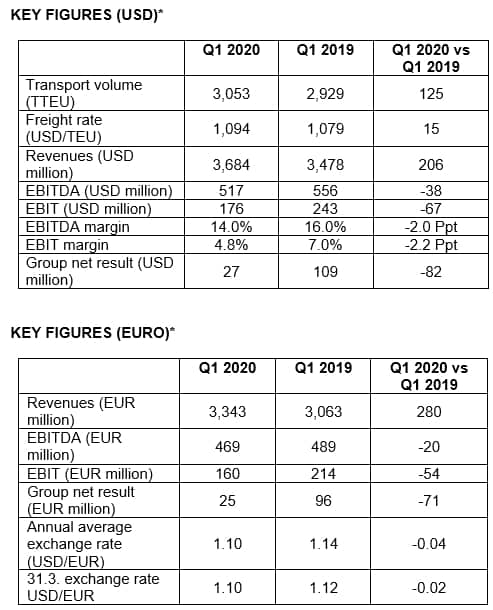While what Hapag-Lloyd called the “economic consequences” of the coronavirus pandemic won’t begin to be understood until at least the end of the second quarter, the German container line said it has the liquidity to remain financially healthy.
Hapag-Lloyd said what did sting in the first quarter of 2020 was higher costs.
For the first quarter of 2020, Hapag-Lloyd recorded earnings before interest and taxes (EBIT) of $176 million (€160 million), down $67 million year-over-year from the $243 million (€214 million) in Q1 2019. Earnings before interest, taxes, depreciation and amortization (EBITDA) decreased by 4.1% to $517 million (€469 million), which Hapag-Lloyd attributed to higher bunker costs.
Group net profit dropped from approximately $103 million (€96 million) to about $27 million (€25 million).
Hapag-Lloyd said despite a big drop in cash flow from operating activities, from €536 million in 2019 to €381 million in 2020, it remains in good shape. It said its cash and cash equivalents totaled $1 billion (€940 million) at the end of Q1, up from $553.7 million (€512 million) in the same period last year.

It said other positives were improved transport volumes and freight rates and cost-saving measures put in place to safeguard the company’s financial performance.
“Despite the coronavirus pandemic, we have gotten the year off to a good start. Higher transport volumes and better freight rates have boosted our revenues. The financial result is below the first quarter of the previous year as we faced higher bunker prices after the new IMO 2020 rules [went into effect Jan. 1] and we had a significant negative bunker stock valuation after the decline in crude oil prices at the end of the first quarter,” said Hapag-Lloyd AG Chief Executive Officer Rolf Habben Jansen.
Revenues increased in the first quarter of 2020 by about 6% to $3.68 billion (€3.3 billion). Hapag-Lloyd attributed this to a 4.3% increase in transport volumes to more than 3 million twenty-foot equivalent units (TEUs), a 1.4% improvement in the average freight rate to $1,094 per TEU and a stronger U.S. dollar.
Transportation expenses increased disproportionately to revenues by about 10%, particularly due to higher bunker costs, which increased from $98 to $523 per tonne as a result of the transition to low-sulfur fuel oil required by the IMO 2020 regulation, Hapag-Lloyd said. This had a negative impact on earnings, as did a devaluation of bunker inventories of about $64 million (approximately €58 million) due to the rapid decline in crude oil prices.
“It’s difficult to imagine today that two and a half months ago we were paying between $600 and $700 a tonne for fuel in Singapore and then we had of course a very sharp decline in the fuel price just before the end of the first quarter,” which resulted in the bunker stock devaluation, Jansen said during an earnings call Friday.
Free cash flow was positive at $302 million (€274 million). At the end of the first quarter, the liquidity reserve stood at about $1.2 billion (€1.1 billion), “a persistently good level,” according to Hapag-Lloyd.
Chief Financial Officer Mark Frese said during the earnings call, “With free cash flow at $302 million, our cash generation in Q1 remains quite strong. Investments were primarily related to containers, ship equipment and retrofitting of ships to ensure compliance with IMO 2020. For reasons of financial prudence and safety, we decided to draw down $400 million out of our annualized RCF in order to minimize risk from increased financial market volatility due to the crisis. The borrowed funds were invested with banks with high ratings and have no impact on the debt.
“With the reported liquidity reserve of slightly more than $1.2 billion, we are very well prepared for even worsening market conditions,” Frese said.
CEO Jansen said Hapag-Lloyd expects significant economic impacts from the pandemic to hit Q2 results.
“We have taken a wide range of measures designed to save an amount in the mid-triple-digit million[-dollar] range to safeguard our profitability and liquidity. We adjust our service network to the lower demand and seek savings in all cost categories, from terminal, transport, equipment and network costs to overhead,” he said.
Still, Hapag-Lloyd’s earnings forecast for 2020 remains unchanged. It expects full-year EBITDA of $1.83 billion (€1.7 billion) to $2.37 billion (€2.2 billion) and EBIT of $540 million (€500 million) to $1.08 billion (€1 billion).
“Clearly volume’s down now in Q2. We still think though that our scenario where we’ll start seeing a gradual recovery somewhere in the course of the third quarter and then a pickup for Q4 is reasonable,” Jansen said.
Hapag-Lloyd noted, however, that “unless there is a recovery in demand for container transport services earlier and stronger than expected in the market studies cited in the financial report for the first quarter 2020, the upper end of the forecast ranges is barely achievable from today’s perspective.”
Jansen had said during a press conference last week that as the coronavirus situation remains fluid, there is a “tremendous amount of uncertainty around all these forecasts.”
He said Friday, “Our main focus for the upcoming weeks and months is to execute the Performance Safeguarding Program, which we will need in order to deliver on our guidance, but we will also slowly but steadily start shifting again more to business as usual and start refocusing on the things that we have identified in the context of our Strategy 2023.”
Hapag-Lloyd had a fleet of 248 container ships as of March 31, up eight from the same time last year. Jansen said during Friday’s earnings call that he expected to return a “double-digit” number of chartered ships this year.







